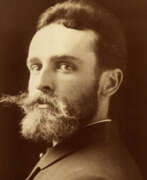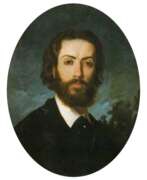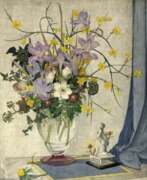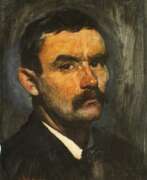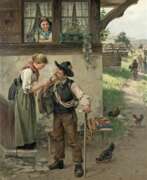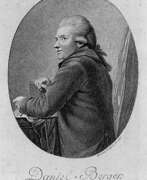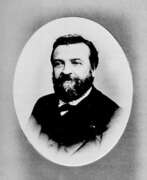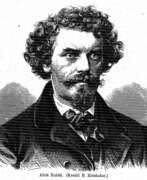Illustrators 19th century


Louise Abbéma was a French painter, sculptor, and designer, celebrated for her work during the Belle Époque. Born in Étampes in 1853 into an affluent Parisian family, she became well known for her portraits, particularly of the famous actress Sarah Bernhardt, and for decorative panels commissioned for various public buildings in Paris and the Palace of the Governor in Dakar, Senegal.
Abbéma's art often depicted the upper echelons of French society and reflected the Impressionist style through her light and rapid brushstrokes. She was also notable for her involvement in the women's movement, where she contributed to the emerging image of the 'New Woman' by portraying androgynous figures and themes of intellectualism and freedom.
Among her many honors, Abbéma was awarded the Palme Academiques in 1887, nominated as the Official Painter of the Third Republic, and in 1906, she became a Chevalier of the Legion of Honour. Her works, such as "Lunch in the Greenhouse" and "Portrait of Sarah Bernhardt," have seen a resurgence in popularity as the contribution of women to historical art gains more recognition.
For those interested in the evocative and historically rich artworks of Louise Abbéma, consider subscribing to our updates. We'll keep you informed about new sales, auctions, and exhibitions featuring Abbéma's work, ensuring you're always connected to the latest offerings in the art and antique collectors' sphere.




William Alexander was a British painter, illustrator and printmaker.
He studied painting at the Royal Academy and became a very famous artist. In 1792-1794 he accompanied the official embassy to Peking of Lord George Macartney on behalf of the British government, where he documented the visit and made many drawings of the Chinese court. These depict various mandarins, merchants, members of the royal family and members of Chinese society. In 1805, William Alexander published Costume of China, an album illustrated with 48 color prints, which was a success with the public.


Henry Thomas Alcken was an English painter and engraver chiefly known as a caricaturist and illustrator of sporting subjects and coaching scenes. His most prolific period of painting and drawing occurred between 1816 and 1831.


Samuel Alken the Elder was a British painter, printmaker and illustrator.
Samuel Alken studied at the Royal Academy School in London. In 1779 he published A New Book of Ornaments Designed and Engraved by Samuel Alken, and later established himself as one of the most distinguished engravers in the new technique of aquatint. Alken produced magnificent compositions of the British countryside, including moonlit night scenes. His works include engravings by George Morland, Richard Wilson, Thomas Rowlandson, and Francis Wheatley. In 1796 his plates of sixteen views of the lakes of Cumberland and Westmorland, after drawings by John Ames and John Smith, were published, and in 1798 a set of aquatint views of North Wales after drawings by the Rev. Brian Broughton.
His sons, Samuel Alken the Younger (1784-1824), Henry Thomas Alken (1785-1851) and Samuel Henry Alken (1810-1894) also became artists.


Boris Izraelievich Anisfeld (Russian: Борис Израилевич Анисфельд) was a Russian-American painter, set designer, illustrator, and educator, celebrated for his vivid use of color and imaginative scenery. Born in Bessarabia, Russian Empire, in 1878, Anisfeld's artistic journey led him from the Odessa School of Art to the Imperial Academy of Arts in Saint Petersburg, where he absorbed the influences of prominent artists like Ilya Repin and Igor Grabar. His distinct style caught the attention of Sergei Diaghilev, leading to his work with the Ballet Russe before World War I.
Anisfeld's contributions to art extend beyond his canvas, as his theater designs for Diaghilev's Ballets Russes and collaborations with notable figures like Michel Fokine and Anna Pavlova showcased his ability to blend fantasy with performance. His work with the Ballets Russes, including designing the production of "Sadko" and executing the visions of other celebrated artists for stage sets, marked a significant period in his career before he immigrated to the United States in 1917.
In America, Anisfeld continued his legacy, taking on roles such as a teacher at the Art Institute of Chicago and contributing to the cultural landscape through his stage designs and paintings. His work is recognized for its innovative approach to color and form, bridging the realms of painting and theater design to create immersive, emotionally resonant artworks. Anisfeld passed away in 1973, leaving behind a body of work that continues to inspire and captivate audiences.
For collectors and experts in art and antiques, Anisfeld's work represents a fusion of Russian and American art traditions, enriched by his imaginative approach and vibrant palette. His contributions to the development of modern art and theater design underscore the enduring relevance of his creative vision.
To stay updated on exhibitions, sales, and auctions related to Boris Israelievich Anisfeld, sign up for updates. This subscription will ensure you're informed about new opportunities to explore and acquire works by this influential artist.


Emilia Appelgren was a Finnish artist, one of the first female landscape painters of 19th century Finland.
Emilia Appelgren was also a good copyist and illustrator. After the establishment of the Finnish Society of Artists in 1846, she studied at art schools at home and abroad.
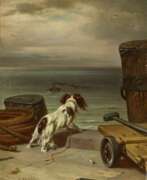

Carl Johann Arnold was a German painter, draftsman, and graphic artist.
He was the son and pupil of the designer and wallpaper maker, landscape and portrait painter, lithographer, and decorator Carl Heinrich Arnold (1793-1874).
He first studied at the Academy in Kassel and then went to Berlin. Carl Johann Arnold painted pictures of animals, canvases on historical events, and numerous portraits. In particular, he created many portraits of the German Emperor Wilhelm II, for which he was apparently appointed royal Prussian court painter. Arnold also produced drawings, etchings, and lithographs that were published in the popular magazines of the time.


Maurice Paul Jean Asselin was a French painter, watercolourist, printmaker, lithographer, engraver and illustrator, associated with the School of Paris. He is best known for still lifes and nudes. Other recurring themes in his work are motherhood, and the landscapes and seascapes of Brittany. He also worked as a book illustrator, particularly in the 1920s. His personal style was characterised by subdued colours, sensitive brushwork and a strong sense of composition and design.
He was awarded the rank of Officier de la Légion d'honneur in 1939.


Robert Assmus is a German landscape artist and illustrator. He took lessons from the floral artist Friedrich Wilhelm Völker. He devoted himself entirely to landscape painting, earning a living by illustrating for the newspapers Illustrirte Zeitung, Die Gartenlaube, Daheim magazine and other publications. After the end of the Franco-Prussian War of 1870-1871, he undertook study trips to northern Italy, the Carpathians, Hungary, the Baltic Sea and Switzerland. Inspired by what he saw, he published a magnificent illustrated work, the album “Alsace-Lorraine,” which received positive reviews from the public.


Charles Garabed Atamian is a French artist of Armenian origin born in Turkey.
He studied for a time at the Academy of Fine Arts in Venice, then worked as chief designer at a porcelain factory in Istanbul. In 1894, Atamian worked with a team of artists to decorate the new palace of Sultan Abdul-Hamid Il in Yildiz, on the European side of the Bosphorus. He designed, among other things, the patterns for the ceramic tiles of the palace walls.
In 1897, Atamian emigrated to France and began illustrating books and magazines, as well as working on sets for several Parisian theaters. Since 1903 Atamian participated in various exhibitions with unquestionable success. He painted landscapes, sea and beach scenes with children (including some 200 paintings at Saint-Gilles in the Vendée, where he resided each year during the summer months from 1923 to 1939). Throughout his career he was a fine portrait painter. He became a member of the National Society of Artists in 1927.
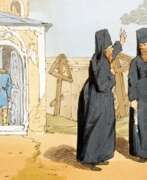

John Augustus Atkinson was a British watercolorist, illustrator and engraver.
In 1784, the young Atkinson traveled to St. Petersburg, Russia, to stay with his uncle James Walker, who worked as an engraver at the court of Empress Catherine the Great. The aspiring artist learned from the work of the great Russian painters whose paintings he saw in the art galleries of St. Petersburg. Catherine and her son Paul I, noticing his talent, commissioned Atkinson to paint pictures on historical subjects.
In 1801 Atkinson returned to England and a year later published an album entitled "Pictorial representation of Russian manners, customs and amusements" on 100 plates drawn and engraved by himself. This work was a great success in Europe. Later, during the Napoleonic Wars, Atkinson created many battle scenes, including the Battle of Waterloo and naval battles. In 1808 he was elected to the Society of Watercolor Painters.


Charles Aubry was a French painter, illustrator and caricaturist who worked in Saumur from 1810-1840.
From 1817. Aubry made drawings and illustrations of military costume. He was soon recognized as one of the best lithographers and draughtsmen of military scenes, showing a particular talent for depicting cavalry. Charles Aubry's colored lithographs were published in a publication on the uniforms of the Swiss Royal Guard (Collection des Uniforms de l'Armee Francaise, 1823), as well as caricatures in the Comic Album de Pathologie (1823).
In 1822 Charles Aubry was appointed professor of art at l'Ecole Militaire de Saumur.


Gottfried Albert Maria Bachem was a German painter and illustrator of the Düsseldorf School. Bachem, who belonged to the Malkasten artists' association from 1921 to 1932, painted portraits, genre scenes and landscapes, and he also illustrated children's books. From 1900 he took part in numerous art exhibitions, including in Berlin.
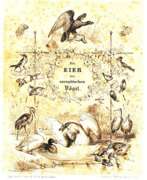

Friedrich Baedeker, full name Friedrich Wilhelm Justus Baedeker or F. W. J. Baedeker, was a German pharmacist, bird egg collector and bird illustrator.
In addition to his work as a pharmacist, Baedeker had a passion for ornithology and was a good artist. His 774 watercolors are known, depicting some 386 European birds. In time, Baedeker became widely known as an ornithologist and zoologist, and his huge collection included about 4,000 eggs of various European and exotic birds.
Baedeker joined the Deutsche Ornithologen-Gesellschaft (German Society of Ornithologists) in 1851, shortly after its founding, and published several books on birds. One of these was Die Eier der europaeischen Voegel nach der Natur gemalt ("The Eggs of European Birds Drawn from Nature").


Friedrich August Baer was a German painter who initially pursued law but turned to painting after being inspired by Eduard Schleich's work. He was a self-taught artist who received guidance from Adolf Lier and Hermann Baisch. Baer was a member of the Munich Art Association and exhibited his works in various exhibitions across Germany and Austria. He became interested in painting high mountain landscapes and was occasionally misunderstood for his unique style. Baer was also a writer and book illustrator and received several medals and awards for his artistic achievements.


Leon Bakst (Russian: Лев Самойлович Бакст) was a prominent Russian painter and stage designer, celebrated for his innovative contributions to the world of art and theater. Born in the late 19th century, Bakst became a central figure in the cultural renaissance that swept through Russia and Europe, leaving an indelible mark on the visual and performing arts.
Bakst's work is distinguished by its rich use of color, intricate patterns, and imaginative compositions, which brought to life the exotic and often fantastical themes of the ballets and operas for which he designed. His association with the Ballets Russes, a groundbreaking ballet company that performed across Europe and America, solidified his reputation as a visionary artist. The costumes and sets he created for productions like "The Firebird" and "Scheherazade" were celebrated for their creativity and exoticism, influencing not only the world of theater but also fashion and interior design.
His art extends beyond the stage, with paintings and illustrations that capture the same vibrancy and innovation found in his theatrical work. Museums and galleries around the world, including the State Russian Museum in St. Petersburg and the Metropolitan Museum of Art in New York, house his works, allowing art lovers to experience the magic of Bakst's creations.
For collectors and experts in art and antiques, Leon Bakst's work offers a unique glimpse into a transformative period of cultural history, where the boundaries of art and performance were reimagined. His legacy continues to inspire and captivate, making his pieces highly sought after in the art world.
We invite enthusiasts and collectors to sign up for updates on new product sales and auction events related to Leon Bakst. This subscription ensures you remain informed about opportunities to acquire pieces connected to this extraordinary artist's legacy, without any overbearing commitments. Join us in celebrating the enduring impact of Leon Bakst's art and design.


Hans Baluschek, full name Alphons Anton Alexander Hans Ernst Karl Maria Baluschek, was a German painter, graphic artist and writer, representative of the New Materiality style.
Baluschek studied at the Royal Academy of Arts, and in 1900 became a member of the Berlin Secession, a group of artists that also included Ernst Barlach, Max Beckmann, and Wassily Kandinsky. Baluschek was always socially critical, which was reflected in the subjects of his paintings. Many of his paintings are dedicated to the working class of Berlin, he addressed the gray everyday life of Berlin: gray air, gray walls, gray people. Baluschek is often categorized as a German Expressionist because of his emotional style, but his style has something of New Objectivity, Impressionism, and naive painting. He also drew illustrations for the popular children's book Little Peter's Trip to the Moon, and collaborated with periodicals as an illustrator.
World War I instilled patriotic feelings in Baluschek, and he painted a number of subjects on this theme. After the war, he joined the Social Democratic Party and became involved in labor movements. In 1926 he helped establish an artists' relief fund and later became director of the annual Berlin Exhibition. The German Nazis, who came to power in 1933, declared Baluschek a Marxist and a "degenerate artist," suspended him from all positions, and banned him from exhibiting.


George Barbier was a French artist and illustrator, fashion designer, who influenced the development of the Art Deco movement.
George Barbier studied painting at the École Nationale Supérieure des Beaux-Arts in Paris. Initially he worked as an illustrator for several famous Parisian fashion magazines, and gradually his drawings began to define the style of women's clothing. The emergence of the Art Nouveau style moved Barbier to create luxurious fashions for cabarets, theaters, and movies. He depicted extravagant theatrical costumes with sparkling rhinestones, high headdresses and huge plumes. Barbier created stage costume designs for Diaghilev's famous Russian Ballet.
He also illustrated catalogs and many literary works, including works by Charles Baudelaire and P. Verlaine, and was an author and designer of jewelry.


James Barenger is a British animal artist and illustrator.
He was born James Barenger Sr. James Barenger was a metal chaser and naturalist painter. Barenger specialized in depicting horses, dogs, and other animals, as well as noblemen's hunting scenes, which were consistently successful in the 19th century.
Barenger's patrons included the Duke of Grafton, the Marquis of Londonderry and the Earl of Derby. The artist produced entire series of prints depicting hunting, shooting, bullfighting and horse racing, which were published in sporting publications.


Henri Charles Antoine Baron was a French painter, printmaker and illustrator.
Henri studied painting with Jean Gigoux (1806-1894) and traveled with him in Italy. The Baron returned with a large number of sketches, which became a constant source of inspiration for many of his later works. He first successfully exhibited at the Paris Salon in 1840. Baron was subsequently honored with several gold medals for his work at this Salon.
Henri Baron was the author of historical scenes of social life, oriental and allegorical compositions. He painted charming Italian genre scenes and depicted Parisian social life. The artist was also recognized as a skilled watercolorist, exhibiting his watercolors continuously at the Society of French Watercolorists since 1879. Baron also illustrated works by Balzac, Boccaccio, J. J. Rousseau, Perrault's fairy tales and many others.
In addition, in collaboration with his friend F.-L. France and Célestin Nantey (1813-73), he published a three-volume edition of Ancient and Modern Painters (1848-62), a collection of lithographs based on the works of modern artists.
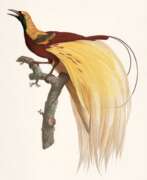

Jacques Barraband was a French zoological and botanical illustrator, renowned for his lifelike renderings of tropical birds. His pictures were based on mounted specimens and his illustration was considered the most accurate ones made during the early 1800s.
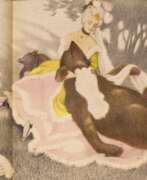

Moritz Bauernfeind was an Austrian painter, graphic artist, illustrator and cartoonist.
Moritz studied at the Academies of Fine Arts in Vienna and Munich, then at the Académie Julian in Paris, early landscapes painted in the style of Impressionism.
Bauernfeind gained fame in the early 20th century as an illustrator of political satire, notably in Meggendorfer's Humorous Notes and Der Flo. Between 1900 and 1905 he published more than 200 satirical drawings in Der Scherer and Simplicissimus, and in 1909 a series in the Illustrirten Zeitung in Leipzig. And color illustrations for fairy tales and legends were eagerly published by juvenile and many other publications. Bauernfeind's fantastic genre images with stylized figures and a touch of burlesque attract with their unusualness and mystery.


Aubrey Vincent Beardsley was an English artist and illustrator, whose brief yet impactful career left an indelible mark on the art world. Born in Brighton, England, in 1872, Beardsley's work was instrumental in the development of the Art Nouveau movement, and he is often remembered for his bold, innovative illustrations that challenged Victorian sensibilities with their erotic and often grotesque imagery.
Beardsley's artistic journey was characterized by his unique ability to blend influences from Japanese woodcuts with the aesthetic of the English Art Nouveau movement. His illustrations are distinguished by their stark contrasts of black and white, intricate details, and the absence of middle tones, creating a dramatic and unmistakable style. He was particularly known for his illustrations for the limited edition of "Le Morte D'Arthur," which were celebrated for their elaborate detail and pre-Raphaelite influences, despite their sometimes grotesque details. This work, along with his contributions to "The Yellow Book" and illustrations for Oscar Wilde's "Salome," showcased his talent for capturing the decadent and the macabre, earning him both acclaim and controversy (Wikipedia, The Collector).
Beardsley's career, though short-lived due to his untimely death at the age of 25 from tuberculosis, was marked by significant contributions to various publications, including "The Studio" and "The Savoy," which he co-founded. His work for "The Yellow Book," where he served as art editor, was particularly influential. The magazine, using the latest image-reproduction technology of the time, allowed Beardsley to make dramatic use of black and white space, reflecting his vision of modern life and aesthetics (V&A Museum).
Despite facing health challenges and controversies, including being dismissed from "The Yellow Book" during the scandal surrounding Oscar Wilde's arrest, Beardsley continued to work on projects that pushed the boundaries of conventional morality and art. His illustrations for works like Aristophanes' "Lysistrata" and his retelling of the Tannhäuser legend are testament to his enduring creative spirit and his willingness to explore themes of decadence, sexuality, and the grotesque.
Beardsley's legacy extends beyond his death, influencing not only the Art Nouveau movement but also future generations of artists and illustrators. His work continues to be celebrated for its daring originality and its challenge to the norms of his time. The Victoria and Albert Museum, among others, has celebrated Beardsley's contributions to art and culture, showcasing his ability to intertwine the beautiful and the grotesque in ways that remain provocative and engaging to this day.
For collectors and experts in art and antiques, Beardsley's work offers a fascinating glimpse into the aesthetic and cultural shifts of the late 19th century. His influence on poster art, illustration, and the broader Art Nouveau movement underlines the significant impact he had during his brief career. To stay updated on sales and auction events related to Aubrey Vincent Beardsley's work, signing up for updates can provide exclusive access to the continuing legacy of this remarkable artist.




Marcus Behmer, full name Marcus Michael Douglas Behmer, known by the pseudonyms Marcotino und Maurice Besnaux, is a German artist, graphic designer and illustrator.
Marcus was the son of the painter Hermann Behmer, participated in World War I and painted miniature portraits of fellow soldiers. From 1900 he began to collaborate with Munich periodicals and book publishers. Bemer drew hundreds of drawings and illustrations and published a series of engravings that were recognized and successful. He also designed typefaces.
In 1936, Behmer was convicted of homosexuality and spent a year and a half in prison, where the artist also found the strength to draw. During World War II, almost all of Bemer's creations were lost or destroyed.


Peter Behrens was a seminal figure in modern design and architecture, heralded as the first industrial designer and a pioneer in modernist architecture. Born in Hamburg, Germany, Behrens's influence spanned across various domains, including architecture, industrial design, and graphic design. His holistic design approach was revolutionary, encompassing everything from architectural projects to corporate identities.
Behrens's association with AEG (Allgemeine Elektrizitäts-Gesellschaft) marked a significant chapter in his career. Hired as an artistic consultant in 1907, he crafted a comprehensive corporate identity for AEG, including the iconic AEG Turbine Factory (1909), a hallmark of industrial classicism and modernism. This work is celebrated for its pioneering approach to industrial architecture and design, integrating form and function with unprecedented clarity and coherence.
His architectural ventures displayed a versatility and an evolution of style, from the monumental, stripped classical form seen in the German Embassy in St Petersburg (1912) and the Administration Building for Continental AG in Hannover (1912-1914), to the expressive Brick Expressionism of the Technical Administration Building of Hoechst AG in Frankfurt (1920-1924). Behrens's work in the 1920s, including the design for the 'New Ways' house in Northampton, UK, and contributions to the Weissenhof Estate in Stuttgart, underscored his shift towards New Objectivity and modernist principles.
Moreover, Behrens's educational contributions were profound, with his teaching stints at the Academy of Fine Arts Vienna influencing a new generation of architects, including luminaries such as Ludwig Mies van der Rohe, Le Corbusier, and Walter Gropius, who would themselves go on to define the course of 20th-century architecture.
Behrens's legacy is a testament to the transformative power of design, illustrating how integrated and forward-thinking approaches can redefine our built environment and the objects we use daily. His work remains an essential study for collectors, experts in art and antiques, and anyone interested in the evolution of modern design and architecture.
For updates on exhibitions and auctions featuring Peter Behrens's work, sign up for our newsletter. Stay informed about new discoveries, sales, and events related to this pivotal figure in modern architecture and design.


Vladimir Georgievich Bekhteev (Russian: Владимир Георгиевич Бехтеев) was a Russian artist and painter, born in 1878 and passing away in 1971. His journey into the art world led him from Russia to Munich on the advice of Sergei Jawlensky, where he was deeply influenced by the artistic and intellectual environment of the city, particularly through his connections with the Jawlensky household and the vibrant café culture. Bekhteev's early works, such as "Autumn Alley" (1905), showcase his assimilation of late Impressionist techniques and the influence of Van Gogh, reflecting a period of significant artistic development during his time in Germany.
Bekhteev's art gained recognition and was collected by prominent figures in the avant-garde art scene. His participation in exhibitions reflects a broad interest in various subjects, from landscapes to memories of Africa, demonstrating his versatility and curiosity as an artist. His works have been featured in international exhibitions and have fetched notable prices at auctions, indicating a continued interest and appreciation for his contributions to Russian and European art.
For collectors and experts in art and antiques, Bekhteev's works represent an intriguing intersection of Russian and European artistic movements in the early 20th century. His unique approach to color, form, and subject matter offers a distinctive perspective within the broader context of Impressionist and post-Impressionist art.
To stay updated on sales and auction events related to Vladimir Georgievich Bekhteev, signing up for updates is highly recommended. This subscription will ensure that enthusiasts and collectors are promptly informed of new opportunities to acquire pieces by this distinguished artist.


Vasiliy Vasiliyevich Belyashin (Russian: Василий Васильевич Беляшин) was a distinguished Russian and Soviet artist, acclaimed for his contributions to the Silver Age of Russian art. Born on September 8, 1874, in Vilnius, within the Russian Empire, and passing on May 8, 1929, in St. Petersburg, USSR, Belyashin's career spanned the late 19th and early 20th centuries, a period marked by significant artistic evolution. His versatility as an artist is evident in his work as a portrait painter, landscape artist, printmaker, and illustrator, with a particular renown for his series of self-portraits.
Operating mainly within the impressionist style, Belyashin's artistry was not confined to a single genre. He excelled across various forms, including landscape painting, portraits, self-portraits, and still life, showcasing a broad skill set that resonated with the Symbolist and Impressionist movements of his time. His educational background and associations with artistic societies, such as the Kuindzhi Society, the Art Community, and the Partnership of Artists, further underline his integral role in the artistic community of his era.
Though detailed records of Belyashin's works in specific museums or galleries were not immediately available, the acknowledgment of his art in auctions and the recognition by cultural institutions suggest a lasting legacy. His work, celebrated for its emotional depth and technical proficiency, continues to capture the imagination of art collectors and enthusiasts alike.
For those intrigued by Vasiliy Vasiliyevich Belyashin's unique contribution to the world of art, staying updated on auctions and exhibitions featuring his work is invaluable. Signing up for updates related to Belyashin can ensure you remain informed about new sales and auction events, offering a chance to connect more deeply with this master's artistic journey.


Alexandre Nikolayevich Benois (Russian: Алекса́ндр Никола́евич Бенуа́) was a distinguished Russian artist, art critic, and historian, celebrated for his pivotal role in the art world, particularly in painting and stage design. Born into a family deeply embedded in the cultural fabric of Russia, Benois was instrumental in the development of the Russian artistic movement at the turn of the 20th century. His contributions to art and culture extend beyond his vivid paintings; he was a founding member of the World of Art (Mir iskusstva), a significant art movement and magazine that sought to elevate Russian artistry on the global stage.
Benois' work is notable for its intricate detailing, vibrant use of color, and the ability to convey deep narratives within each piece. His designs for ballets such as "Petrushka" and "The Sleeping Beauty" remain iconic, showcasing his mastery over the fusion of visual art and performance. This synthesis not only enhanced the ballets’ visual appeal but also deepened the audience's engagement with the narrative. Museums and galleries around the world, including the Russian Museum in St. Petersburg and the Tretyakov Gallery in Moscow, house his works, underscoring his global recognition and the enduring appeal of his artistic vision.
For collectors and experts in art and antiques, Benois' oeuvre represents a fascinating exploration of early 20th-century Russian culture, art, and the avant-garde movement. His ability to blend traditional Russian themes with the modernist trends of his time makes his work a valuable study in the evolution of modern art. Those interested in the rich tapestry of Russian cultural history and the interplay between art and performance will find Benois' contributions invaluable.
To stay informed about new discoveries, sales, and auction events related to Alexandre Nikolayevich Benois, we encourage you to sign up for updates. This subscription is tailored specifically for enthusiasts eager to deepen their appreciation and understanding of Benois' legacy, ensuring you're the first to know about opportunities to acquire pieces connected to this luminary of Russian art.


Etienne Prosper Berne-Bellecour was a French artist. He was a painter, illustrator, and engraver who specialized in military scenes, battlefields, and portraits of soldiers. He is considered one of the most important French artists of the 19th century.
Berne-Bellecour began his career as an illustrator for French newspapers and magazines. He later became a painter, and in 1863 he exhibited his first painting at the Salon in Paris. In 1873, he became a member of the Académie des Beaux-Arts.
Berne-Bellecour was known for his highly detailed and realistic paintings of military life. He often depicted battle scenes with soldiers in uniform, and his attention to detail was highly admired. He was also known for his portraits of military leaders, including Napoleon III and Marshal MacMahon.
Berne-Bellecour continued to paint and exhibit his work throughout his life.


Sophie Antonie Biel was a German landscape painter and illustrator.
Despite the fact that it was very difficult for women in the mid-19th century to engage in creative work, Antonie Biel created a large number of coastal landscapes of the Baltic and North Seas. She also illustrated novels and was a participant in numerous exhibitions.


Ivan Yakovlevich Bilibin (Russian: Ива́н Я́ковлевич Били́бин) was a Russian illustrator, stage designer, and teacher, famed for his fairy tale illustrations and stage designs that drew heavily from Russian folklore and traditional art. Born in 1876 in St. Petersburg and passing away in 1942 during the Siege of Leningrad, Bilibin's career spanned a period of great change in Russia, from the pre-revolutionary times through to the Soviet era. His work is celebrated for its intricate detail, vibrant colors, and deep homage to Slavic myths and legends.
Bilibin's journey into the world of art and folklore began after his studies at the St. Petersburg University and the Munich art school. He was deeply influenced by Russian folklore, as well as modern French and Japanese art. This amalgamation of influences resulted in a unique style that made his work stand out. His illustrations for Russian folk tales, such as "The Frog Princess," "Vasilisa the Beautiful," and "Marya Morevna," are among his most celebrated works, encapsulating the essence of Russian narrative traditions.
Bilibin's career was not confined to illustration. He made significant contributions to the world of theater, designing sets for operas and ballets that further entrenched his reputation. His work took him beyond Russia, with periods spent in Egypt and France, where he continued to produce work for the Russian émigré and European communities. Despite the political turmoil of his time, Bilibin remained deeply connected to his roots, returning to Soviet Russia in 1936, where he continued his artistic and academic pursuits until his death in 1942.
For collectors and experts in art and antiques, Bilibin's works represent a bridge between the mystical past and the artistic innovations of the early 20th century. His legacy is preserved in museums and galleries worldwide, offering a glimpse into a world where folklore and art intertwine.
If you are keen to explore more about Ivan Yakovlevich Bilibin's remarkable contributions to art and folklore, consider signing up for updates. This subscription will keep you informed about new sales, auctions, and exhibitions related to Bilibin's work, ensuring you never miss an opportunity to engage with the magical worlds he created.
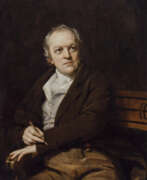

William Blake was an English poet, painter, and printmaker. Largely unrecognised during his life, Blake is now considered a seminal figure in the history of the poetry and visual art of the Romantic Age. What he called his "prophetic works" were said by 20th-century critic Northrop Frye to form "what is in proportion to its merits the least read body of poetry in the English language". His visual artistry led 21st-century critic Jonathan Jones to proclaim him "far and away the greatest artist Britain has ever produced". In 2002, Blake was placed at number 38 in the BBC's poll of the 100 Greatest Britons. While he lived in London his entire life, except for three years spent in Felpham, he produced a diverse and symbolically rich collection of works, which embraced the imagination as "the body of God" or "human existence itself".


Ludwig Blume-Siebert was a German genre painter and illustrator. He studied painting at the Dusseldorf Academy of Fine Arts and the Munich Academy of Fine Arts.
Ludwig Blume-Siebert mainly depicted idyllic and folk scenes of village life, often with children.


Hans Bohrdt was a German marine painter and graphic artist. Bohrdt's journey into marine painting began after a visit to the Hamburg port at the age of 15, sparking a lifelong passion for the sea and maritime subjects. Unlike many artists of his time who had formal art education, Hans Bohrdt was largely self-taught, although he did attend the Academy of Fine Arts in Berlin for a period. His dissatisfaction with the conventional training led him to pursue a more hands-on approach to his art, focusing on seascapes and marine life.
Hans Bohrdt's work gained significant recognition during the Wilhelmine era, making him a celebrated figure in German marine painting, a genre that became particularly prominent after the unification of Germany in 1871. His close relationship with Kaiser Wilhelm II, who was an admirer and patron of his work, helped elevate Bohrdt's status further. Bohrdt's art was known for its technical skill, particularly in depicting the majesty of the sea and the vessels that traversed it. His pieces often featured German naval prowess and were used for both private collections and public display, contributing to national pride and naval propaganda, especially during World War I.
The legacy of Hans Bohrdt is marked by his ability to capture the spirit and grandeur of maritime life, making him a significant figure in the history of German art. Despite the challenges posed by the world wars, which led to the loss of many of his works including his best-known painting, "Der letzte Mann" ("The Last Man"), Bohrdt's art continues to be celebrated for its contribution to marine painting. In 1995, on the fiftieth anniversary of his death, a memorial exhibition was held, showcasing his contributions to the field and reaffirming his place as one of the last great marine painters.
For collectors and experts in art and antiques, Hans Bohrdt's work offers a unique glimpse into the development of marine painting in Germany, reflecting both the beauty of the maritime world and the historical context of his times. To stay informed about sales, auction events, and updates related to Hans Bohrdt's work, signing up for newsletters from galleries and auction houses specializing in maritime art and antiques is recommended. This ensures enthusiasts and collectors are well-informed about opportunities to acquire pieces by this distinguished artist.


Pierre Bonnard was a distinguished French painter and printmaker, recognized as one of the foremost colorists of modern art. Born on October 3, 1867, in Fontenay-aux-Roses, France, Bonnard initially pursued law studies before embracing his true calling in art. He attended the École des Beaux-Arts and the Académie Julian, where his journey as an artist began in earnest.
Bonnard's art is characterized by its vibrant use of color and the portrayal of intimate, sunlit domestic interiors and gardens. His works often include scenes populated with friends and family, creating a narrative that is both personal and relatable. His distinctive style was influenced by Japanese prints, evident in his use of bold patterns and flat color planes. This influence earned him the nickname "Le Nabi très japonard" among his peers in the Les Nabis group, an avant-garde artists' group he joined in his twenties.
His early work, such as "Woman in Checkered Dress" (1890), showcases the influence of Japanese prints. Bonnard's talent was evident from the beginning of his career, with Claude Roger-Marx noting in 1893 his ability to capture fleeting poses and expressions. His work evolved over time, moving towards a style that resonated with the Intimists' focus on personal and intimate spaces.
Bonnard's wife, Marthe, was a recurring subject in his paintings, often depicted in everyday scenarios. Their relationship, spanning several decades, was a significant influence on his work. His paintings, such as "Dining Room on the Garden" and "Landscape at Le Cannet," demonstrate his mastery in capturing light and color, creating a sense of warmth and intimacy.
Bonnard's work remains influential and celebrated, with his paintings held in esteemed collections worldwide. His ability to transform everyday scenes into vibrant, color-filled canvases has made him a beloved figure in the world of modern art.
Art collectors and experts in the field will find Bonnard's work a study in the transformative power of color and composition. For those interested in staying updated on sales and auction events related to Pierre Bonnard's works, signing up for updates would provide valuable insights into this remarkable artist's enduring legacy.


Louis Boulanger was a French Romantic painter, pastellist, lithographer, and poet, celebrated for his contribution to the Romantic Movement and his close associations with notable figures like Victor Hugo. Louis Boulanger's early career was marked by his romantic and allegorical subjects, but it was his shift to more detailed design and classical literature inspiration around 1835 that defined his most productive years. His travels to Spain in 1846 alongside Dumas and others exposed him to the works of masters like Goya and Diego Velázquez, influencing a return to romantic techniques in his later works.
Louis Boulanger's legacy includes the portrayal of several personalities through his portraits, among them George Sand, Victor Hugo, and Petrus Borel, showcasing the influence of various artists including Antoine-Jean Gros and Francisco Goya. Despite some critique for the 'literary' inspiration behind his creations, his pastel sky studies prefigure artists like Paul Huet and Eugène Boudin. Notable works by Louis Boulanger, such as "Supplice de Mazeppa" and "La Ronde du Sabbat," can be found in prestigious French collections, including the Louvre and the Maison de Victor Hugo.
An exhibition titled "Louis Boulanger, peintre rêveur" at the Maison de Victor Hugo, which ran from November 2022 to March 2023, aimed to reintroduce his work, highlighting Boulanger as a central figure in the Romantic circle closely associated with Victor Hugo. This exhibition not only paid tribute to Boulanger but also emphasized his diverse oeuvre, spanning paintings, lithographs, theatrical costume designs, illustrations, and decors, revealing him as one of the main inventors of Romanticism.
If you're interested in the world of art and antiques and wish to stay updated on new product sales and auction events related to Louis Boulanger, signing up for updates is a valuable resource. This subscription will ensure you're informed about the latest opportunities to engage with Boulanger's enduring artistic legacy.


Johan Coenraad Braakensiek was a Dutch painter, illustrator and political cartoonist. For most of his career, Braakensiek worked for a number of publishers as an illustrator. However, he also found work as a political cartoonist for the magazines Geïllustreerd Politie-Nieuws, De Amsterdammer and De Groene Amsterdammer. His first work was with Geïllustreerd Politie-Nieuws where he contributed infrequently. His break and rise in popularity came in 1886 when he was made the political cartoonist for De Amsterdammer magazine. He also was affiliated with De Groene Amsterdammer magazine from 1925 to 1931. Braakensiek remains popular thanks to the books he worked on as illustrator. Books such as Van Allerlei Slag and Uit het leven van Dik Trom, which feature his art are widely known and read.


Karl Alexander Brendel was a German painter, son of the painter Albert Brendel.
He studied at the Académie Julian in Paris, was a member of the Prussian Academy of Arts in Rome, and worked as a professor at the State Academy of Fine Arts in Weimar. Brendel mainly drew animals and landscapes and illustrated children's books.




Karel Brož (Russian: Карл Осипович Брож) was a Czech and Russian artist, renowned for his detailed illustrations and watercolors. Born on November 25, 1836, in Prague, he studied at the Vienna Academy of Fine Arts and later moved to Russia, where he became a prominent illustrator for various publications, including "Vsemirnaya Illustratsiya."
Brož's work is characterized by its meticulous attention to detail and vibrant depictions of historical and everyday scenes. His illustrations, particularly for Russian periodicals, captured the essence of 19th-century life and remain highly regarded in art circles.
Collectors value Brož's pieces for their historical significance and artistic quality. His illustrations have been featured in numerous exhibitions and are part of prestigious collections. For those interested in historical illustrations, Karel Brož’s work offers a unique glimpse into the past.
Sign up for updates on new product sales and auction events related to Karel Brož to stay informed about the latest opportunities to acquire his work.


Umberto Brunelleschi was an Italian artist. He studied at the Accademia delle Belle Arti in Florence and moved to Paris in 1900 with Ardengo Soffici where he soon established himself as a printer, book illustrator, set and costume designer.


Georg Conrad Ludwig Burger was a German historical painter, illustrator, and medallist. He studied at the Berlin Art Academy, at the same time working at book illustrating; he was also a pupil of Thomas Couture in Paris. Among his best drawings are the illustrations for the works of La Fontaine and a collection of 20 plates known as Die Kanone. After 1869, he devoted himself to decorative painting, his most important work in this line being the walls and ceilings in the Berlin City Hall (1870) and the colossal figures symbolizing the warlike virtues at the School of Cadets at Lichterfelde (1878).




Randolph Caldecott was a British artist and illustrator, born in Chester. The Caldecott Medal was named in his honour. He exercised his art chiefly in book illustrations. His abilities as an artist were promptly and generously recognised by the Royal Academy. Caldecott greatly influenced illustration of children's books during the nineteenth century. Two books illustrated by him, priced at a shilling each, were published every Christmas for eight years.
Caldecott also illustrated novels and accounts of foreign travel, made humorous drawings depicting hunting and fashionable life, drew cartoons and he made sketches of the Houses of Parliament inside and out, and exhibited sculptures and paintings in oil and watercolour in the Royal Academy and galleries.












